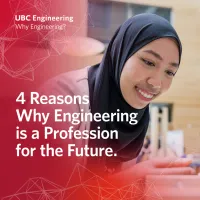"Do all the school things you can; take advantage of the opportunities that are there."

Rebecca Howes
- Degree: Bachelor of Applied Science
- Grad year: 2019
- Program:
- Campus: Vancouver
Job: Ports and Marine Engineer at WSP
Tell us about your job at WSP.
Since January 2023 I’ve been part of WSP’s ports, marine and coastal team, working on structures built near water, like ports, terminals and marinas.
The projects range in size, from small marine harbours to larger-scale projects like upgrading a coal export terminal in Delta.
Another big project I’m involved in is working with the Department of National Defence to replace two 70-year-old jetties at Esquimalt. WSP is the consultant completing the demolition of one of the jetties and designing its replacement, which includes onshore works such as a yard tunnel and combi wall, which is a combination of a piled and sheet-piled retaining wall.
We also designed their substation building, along with the associated mechanical, electrical and other services. It’s a cool project, because it’s not every day that you get to design and replace these massive structures.

What do you need to consider as a structural engineer working in marine environments?
One big factor is what we call metocean conditions. That’s where we rely on coastal engineers who model wind, wave conditions, current and a lot more. We use this information to calculate the additional load associated with these factors that are acting on the structures.
We also have to consider the lifespan of materials. Saltwater is very corrosive, and it’s important to choose materials, incorporate coatings that reduce corrosion, or design maintenance programs to maintain the structure’s integrity.
And then you need to think about the actual construction! You may be restricted to certain times of day that you can work because of tides, and if there are divers involved, there’s a limit to how deep they can go and for how long.
There are so many elements to consider, which is one of the reasons I really like working in this field.

Any highlights from your degree?
I took a coastal engineering course in fourth year that was very interesting. The class was hard, but I learned things I use every day in my job. I still have my notes that I sometimes go back to!
Were you involved in any clubs?
When I transferred to Civil Engineering, I joined the Civil Club because I wanted to meet people in the program. I helped put on an alumni and student event that’s still going annually, and seems to get better every year.
There’s a lot of value that comes from meeting alum who graduated five, 10 or even 30 years ago.
In my last year, I was president of the club, which was time consuming but also helped me gain a lot of skills in project management.






